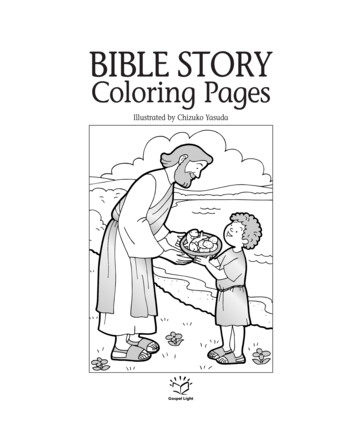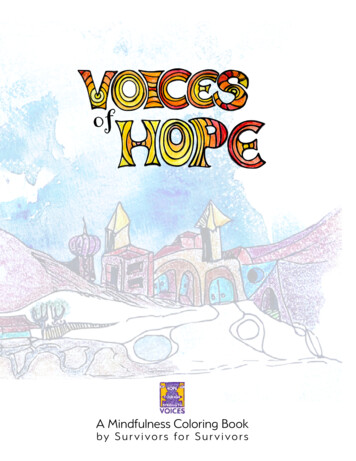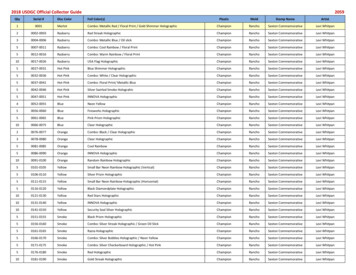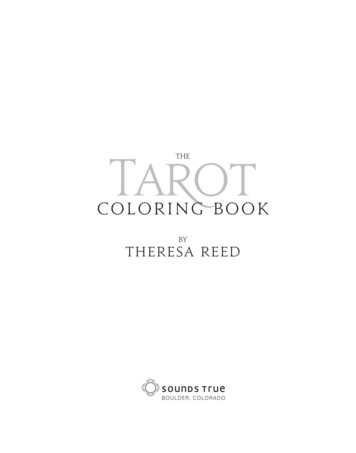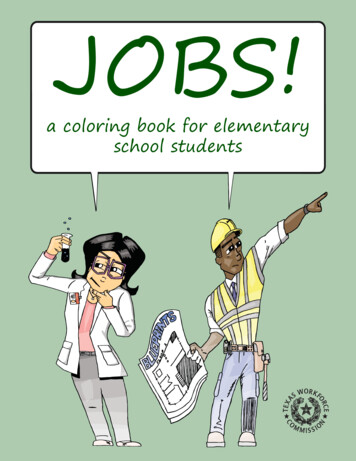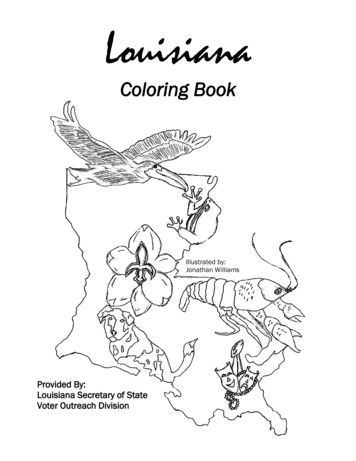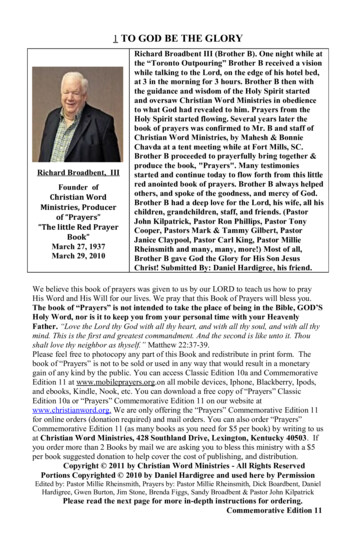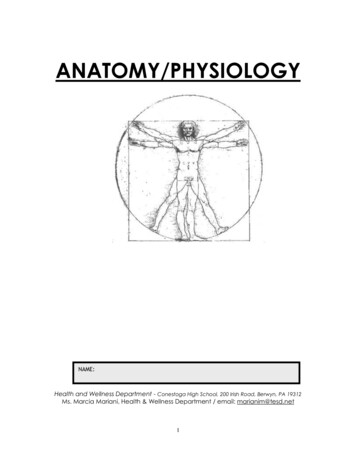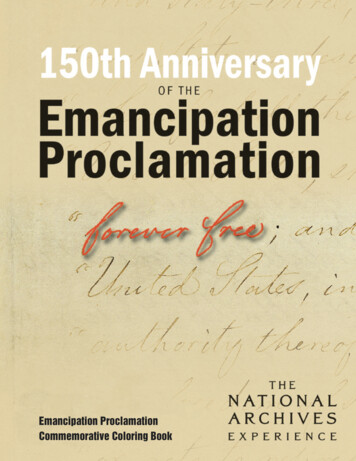
Transcription
Emancipation ProclamationCommemorative Coloring Book
President Abraham Lincoln issued the EmancipationProclamation on January 1, 1863, announcing,"that all persons held as slaves. . . henceforwardshall be free."This book belongs toI celebrated the 150th Anniversary ofthe Emancipation Proclamation at theNational Archives, Washington, D.C.
The Emancipation ProclamationThe Emancipation Proclamation was an order issued byPresident Abraham Lincoln that began the process of freeingall the slaves in the United States. It was signed January1, 1863. The order freed all slaves held by the ConfederateStates that were not in control of Union forces. The Emancipation Proclamation, followed by the 13th Amendment tothe Constitution, would eventually free four million enslavedAmericans.The order also allowed freed slaves to join the U.S. military. By the end of the Civil War in 1865, 200,000 AfricanAmerican troops, most of whom were former slaves, servedin the Union armed forces. These added troops, as well asthe political effect of the Emancipation Proclamation, helpedthe Union win the Civil War.As a milestone along the road to end slavery, with thepost–Civil War struggles, and the modern legacy of civilrights, the Emancipation Proclamation has assumed a placeamong the great documents of human freedom.
The Emancipation Proclamation Story and LegacyAbraham Lincoln,the 16th President of theUnited States, and his Cabinet members read over theEmancipation Proclamation, which proclaimed the freedomof slaves in the 10 states rebelling against the Union in theCivil War. Lincoln first presented the Emancipation Proclamationto his Cabinet on July 22, 1862, and issued the PreliminaryProclamation on September 22, 1862. The EmancipationProclamation took effect on January 1, 1863.(Maria is writing)
On December 31, 1862,many enslaved African Americans gathered in churches andprayed. Throughout the night, they waited for the moment when the Emancipation Proclamation would takeeffect. This special night became known as “WatchNight,” and continues to be celebrated today in manyAfrican American churches on New Year’s Eve.
By the light of a torch held by a young boy,a group of African Americans listened to thereading of the Emancipation Proclamationpublished in a newspaper. It is read by asoldier in the Union Army.
Frederick Douglass(February 1818 – February 20,1895) was an American socialreformer, orator, writer, andstatesman. After escaping fromslavery, he became a leaderof the abolitionist movement,gaining fame for his dazzlingoratory and clear and directantislavery writing. Douglasswas a firm believer in theequality of all people, whetherblack, female, Native American, orrecent immigrant, and wasfamously quoted as saying, “Iwould unite with anybodyto do right and withnobody to do wrong.”
Harriet Tubman(1820–March 10, 1913) was anAfrican American abolitionist,humanitarian, and Union spy during the Civil War. Born into slavery, Tubman was able to escape,and later made more than 13missions to rescue morethan 70 slavesusing the network ofabolitionists (peopleagainst slavery)known as the“Underground Railroad.” She laterjoined the fightto win women theright to vote.
Martin Luther King, Jr.(January 15, 1929 – April 4, 1968)was an American minister,activist, and prominentleader in the Civil RightsMovement. At the 1963March on Washington,King delivered hisfamous “I Have aDream” speech, andestablished hisreputation as oneof the greatestpublic speakers inAmerican history.
Rosa Parks(February 4, 1913 – October 24, 2005)is often called “the mother of themodern civil rights movement.”On December 1, 1955, inMontgomery, Alabama, shewas arrested when sherefused to give up her seaton a bus to a white, malepassenger. This act ofbravery inspired theMontgomery Bus Boycott, ledby Martin Luther King, Jr.,and began a movement thatended legal segregationin America.
Barack Obamais the 44th President of theUnited States. He served inboth the Illinois StateSenate and the U.S.Senate before beingelected President of theUnited States in 2008.He was re-elected in2012. He lives at theWhite House with hiswife, First Lady MichelleObama, and his daughters Malia, 14, andSasha, 10.
Proclamation What Freedom Means to MeDraw a picture or write about what freedom means to you.
ResourcesFor more information about what you have seen at the National Archives, checkout the following web sites:The National Archives: www.archives.govDocsTeach: www.docsteach.orgInteractive online resource of learning activities featuringdocuments at the National Archives.RECOMMENDED READINGSCory, Shana. Barack Obama: Out of Many, One. Random House Publishers,New York, New York. 2009Davidson, Margaret. Frederick Douglass Fights for Freedom. Scholastic Publishing,New York, New York. 1989Landau, Elaine. The Emancipation Proclamation: Would You Do What Lincoln Did?Enslow Publishers, Berkeley Heights, New Jersey. 2010McDonough, Yona Zeldis. Who Was Rosa Parks? Grosset and Dunlap Publishers,New York, New York. 2010McMullan, Kate. The Story of Harriet Tubman: Conductor of the Underground Railroad.Dell Publishing, New York, New York. 1990Ruffin, Frances. Martin Luther King, Jr. and the March on Washington.Penguin Publishers, New York, New York. 2000Sherman, Pat. Ben and the Emancipation Proclamation.Wm. B. Eerdmans Publishing Company, Grand Rapids, Michigan. 2009CREDITSPage 2: First Reading of the Emancipation Proclamation by President Lincoln to his Cabinet, United States SenatePage 3: Waiting for the hour [Emancipation] December 31, 1862, Prints and Photography Division, Library of CongressPage 4: Reading the Emancipation Proclamation, Prints and Photographs Division, Library of CongressPage 5: Portrait of Frederick Douglass, Collections of the New-York Historical SocietyPage 6: Portrait of Harriet Tubman, Moorland-Spingarn Research Center, Howard UniversityPage 7: Portrait of Dr. Rev. Martin Luther King, Jr., Harmon Foundation Collection, National ArchivesPage 8: Rosa Parks, National ArchivesPage 9: President Barack Obama, The White HouseProduced by the Education and Public Programs Division, National Archives
The 150th anniversary celebration of the Emancipation Proclamation ispresented in part by the Verizon Foundation.
Commemorative Coloring Book. President Abraham Lincoln issued the Emancipation Proclamation on January 1, 1863, announcing, "that all persons held as slaves. . . henceforward shall be free." This book belongs to I celebrated the 150th Anniversary
